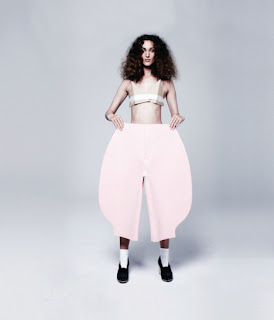 |
| Rick Owens after showing a collection |
Alas,
fashion week (or, more accurately, month) has come and gone, and I was
disappointed to find few shows of especial note. Will Zuhair Murad, with his albeit
beautiful, romantic gowns, ever take a risk? Why all those Frankendresses by
Prada?
In light of the meagre pickings this season, I turn to
Rick Owens, who, if nothing else, managed to cause a stir at his show.
Diversity or Adversity?
Designer
Rick Owens surprised everyone at Paris fashion week when the runway lit up to
reveal a group of muscular, broad, (and mostly) black step dancers. His show,
called Vicious, featured four university student step groups: the Soul Steps and Momentum from New York and the Washington Divas
and Zetas from the D.C. area (Refinery29).
Marching to a percussion-heavy beat, the ladies synchronically clapped and
marched, wearing snarling faces as well as Owen’s latest designs throughout the
energetic performance. (Watch the video here.)
 |
| The steppers wore minimal utilitarian designs |
The problem? As Shauntele, one of the steppers
admitted, “There has been concern from some that our performance perpetuated
stereotypes of the 'angry black woman' due to the use of the grit face.” (Grit refers the intense, angry
expressions black step teams wear to intimidate competition and show strength
in spite of atrocities suffered.) Critics contend that, when taken out of the
context of step competition, the meaning of
grit is lost; the performers’ scowls are too easily interpreted as
“animalistic,” making black women seem more “other” than ever.
 |
| Steppers put on the "grit" face |
Amanda Williams, columnist for The Grio, supports this view when she writes,
“Beauty, whether we believe it is socially
salient, was not portrayed by the models in Owens’ show.” Instead of
celebrating diversity and inclusivity, Owens used seemingly mad black women as
“props,” an act of cultural appropriation on par with Miley Cyrus’s twerking in
her 2013 VMA performance.
Do you think Owens’s attempt to
include black women into mainstream fashion was a failure? Or did he, as
Shauntele believes, successfully challenge
standards of beauty (i.e., thin, white, classically beautiful females) that
have dominated the fashion industry to the “detriment of untold numbers of
women” (Refinery29)?
My two cents: although Owens’s presentation of
his newest collection was not unproblematic, he has inspired a dialogue about
race and gender issues on the runway—a hard task to achieve. It’s enough for me
to give the historically rebellious designer a nod of approval.
About Rick Owens
Rick Owens is an American expatriate to Paris. He learned how to make clothes by taking courses at
Otis/Parson’s, though he dropped out partway through school to make sportswear and designer knock-offs in the L.A. area. (You can still detect the sportswear influence in his spring 2014 collection, which is streamlined, functional, and minimal.)
 |
| Revillon Fur Co. ad from 1926 |
In 1994, Owens began a label of his own, eventually landing in Barney’s and winning the
Perry Ellis Award forEmerging Talent for his efforts. After moving to Paris, he worked as artistic director at
Revillon, a luxury furrier.
Later, in 2008, Owens opened his first boutique store in Manhattan, which showcased the work we know him for today: “savagely sophisticated rock couture” (
Style.com). His palette is mostly black, his best-known medium is leather, and he doesn’t shy away from a little exposed hardware:
Owens' asymmetrical dresses; long,
clingy T-shirts; and embellished outerwear have been seen on hard/soft types
like Courtney Love and Madonna, and the designer's fan club buys up his clothes
with a cultlike alacrity. (Style.com)
 |
| Rihanna |
 |
| Russell Brand |
 |
| Ad for Owens' shop in London, England |
 |
| Editorial in i-D Magazine featuring the designer peeing into his own mouth(!) |
 |
| Spring 2011 |
 |
| Spring 2011 |
 |
| Boxy high-collar jacket and sheer-neck back-zip dress |
 |
| Dress by Owens |
 |
| Owens is just as well known for his men's wear |
 |
| Asymetrical-zip blistered leather jacket |









































